Principles of Education for Health Professionals: Dementia Case Study
VerifiedAdded on 2021/05/31
|10
|2938
|18
Case Study
AI Summary
This case study examines the management of an 80-year-old female patient, Mary, diagnosed with vascular dementia. Presented during a clinical residency at Methodist Hospital in Texas, USA, the case details the patient's symptoms, the challenges faced by her and her family, and the interventions implemented by the healthcare team. The study delves into the causes and characteristics of dementia, including Alzheimer's disease and other related conditions. It highlights the importance of contextual issues, such as the learning environment and nutritional needs, in healthcare settings. The analysis proposes strategies for improving health education for individuals with dementia and their caregivers, emphasizing person-centered care and community integration. The case study also discusses practical considerations for patient care, including communication techniques, hygiene practices, and strategies to address potential complications. The case study emphasizes the significance of involving patients in their own care and leveraging innovative technologies for better management of dementia. It provides a valuable resource for healthcare professionals and students, with a focus on improving the quality of life for patients with dementia.
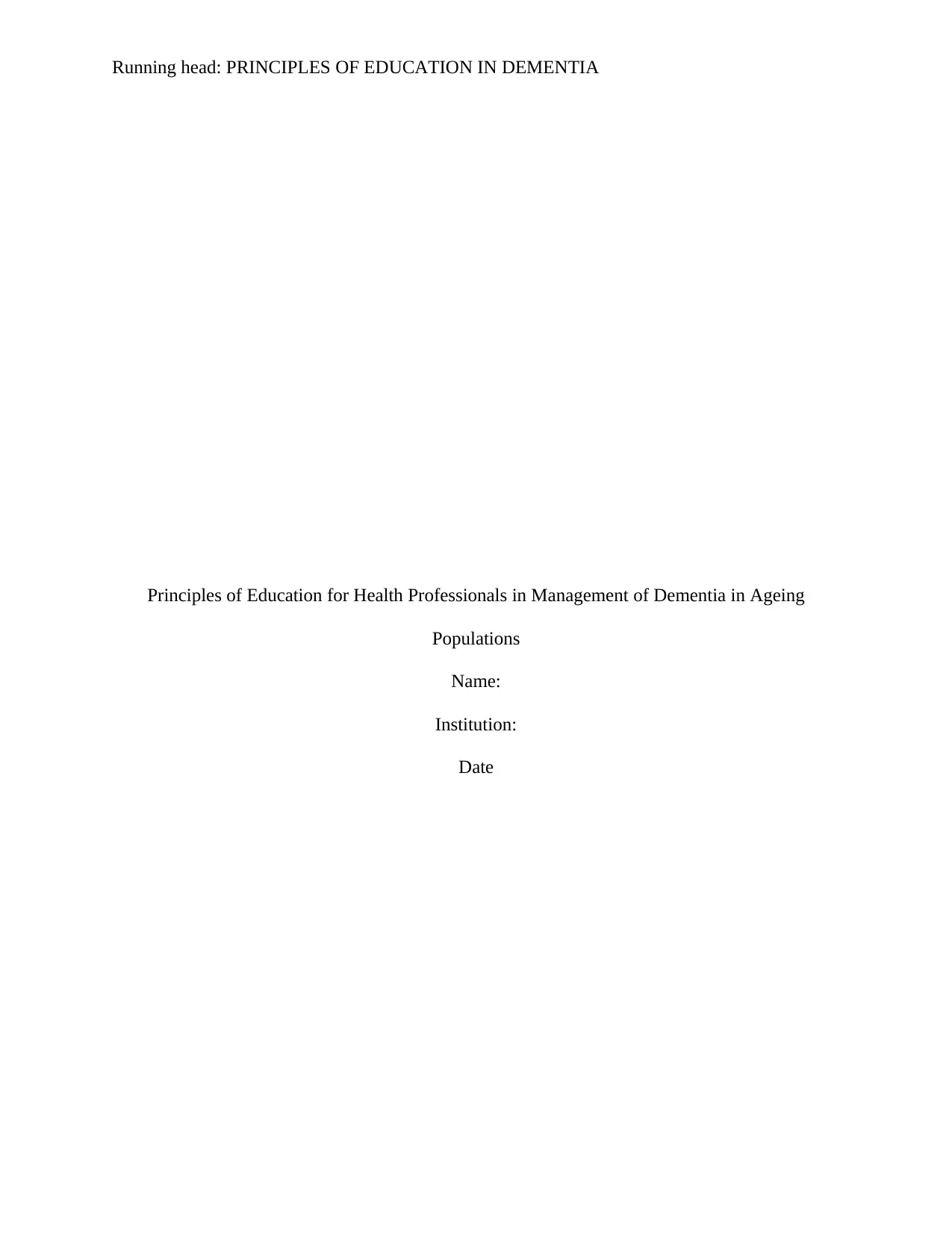
Running head: PRINCIPLES OF EDUCATION IN DEMENTIA
Principles of Education for Health Professionals in Management of Dementia in Ageing
Populations
Name:
Institution:
Date
Principles of Education for Health Professionals in Management of Dementia in Ageing
Populations
Name:
Institution:
Date
Paraphrase This Document
Need a fresh take? Get an instant paraphrase of this document with our AI Paraphraser
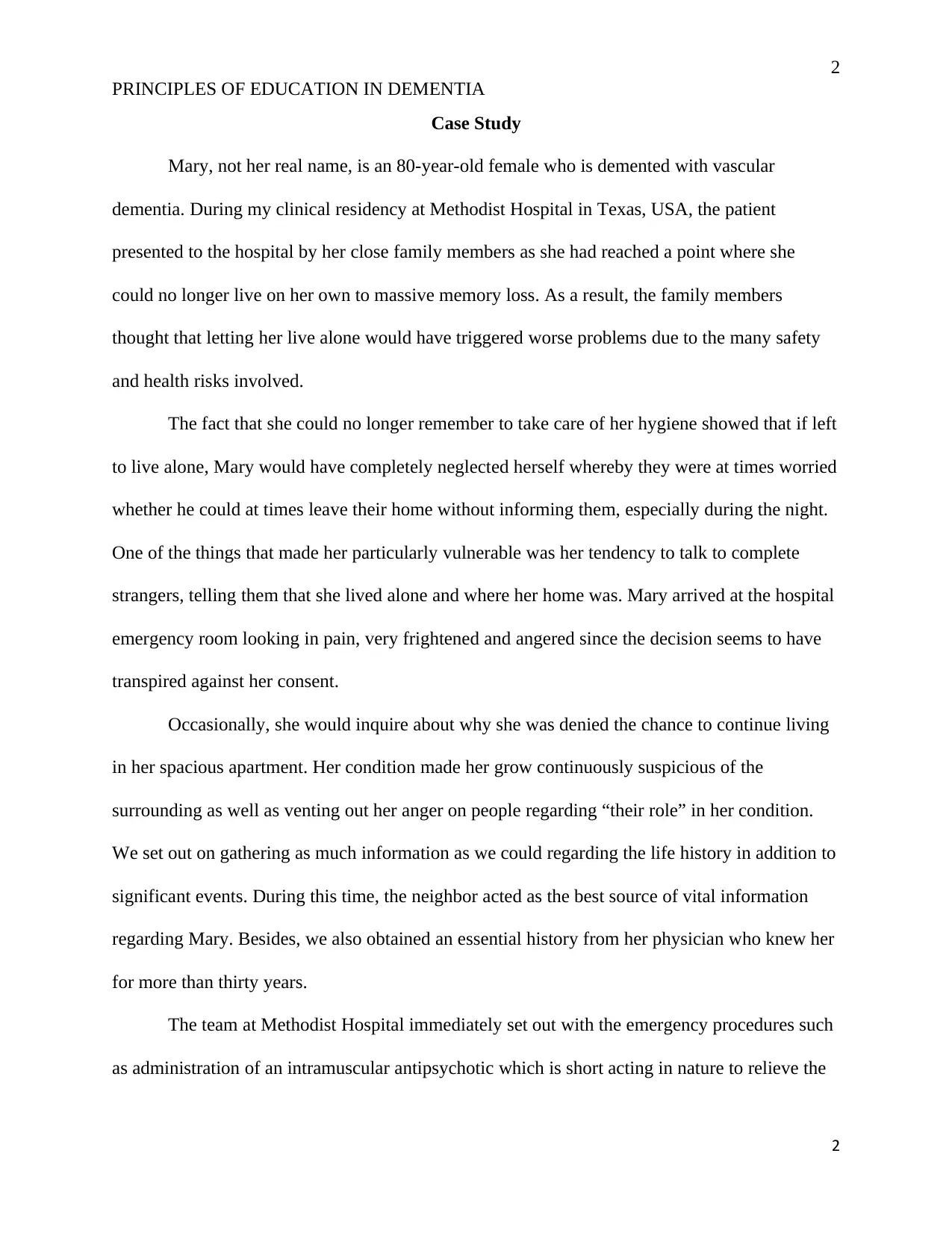
2
PRINCIPLES OF EDUCATION IN DEMENTIA
Case Study
Mary, not her real name, is an 80-year-old female who is demented with vascular
dementia. During my clinical residency at Methodist Hospital in Texas, USA, the patient
presented to the hospital by her close family members as she had reached a point where she
could no longer live on her own to massive memory loss. As a result, the family members
thought that letting her live alone would have triggered worse problems due to the many safety
and health risks involved.
The fact that she could no longer remember to take care of her hygiene showed that if left
to live alone, Mary would have completely neglected herself whereby they were at times worried
whether he could at times leave their home without informing them, especially during the night.
One of the things that made her particularly vulnerable was her tendency to talk to complete
strangers, telling them that she lived alone and where her home was. Mary arrived at the hospital
emergency room looking in pain, very frightened and angered since the decision seems to have
transpired against her consent.
Occasionally, she would inquire about why she was denied the chance to continue living
in her spacious apartment. Her condition made her grow continuously suspicious of the
surrounding as well as venting out her anger on people regarding “their role” in her condition.
We set out on gathering as much information as we could regarding the life history in addition to
significant events. During this time, the neighbor acted as the best source of vital information
regarding Mary. Besides, we also obtained an essential history from her physician who knew her
for more than thirty years.
The team at Methodist Hospital immediately set out with the emergency procedures such
as administration of an intramuscular antipsychotic which is short acting in nature to relieve the
2
PRINCIPLES OF EDUCATION IN DEMENTIA
Case Study
Mary, not her real name, is an 80-year-old female who is demented with vascular
dementia. During my clinical residency at Methodist Hospital in Texas, USA, the patient
presented to the hospital by her close family members as she had reached a point where she
could no longer live on her own to massive memory loss. As a result, the family members
thought that letting her live alone would have triggered worse problems due to the many safety
and health risks involved.
The fact that she could no longer remember to take care of her hygiene showed that if left
to live alone, Mary would have completely neglected herself whereby they were at times worried
whether he could at times leave their home without informing them, especially during the night.
One of the things that made her particularly vulnerable was her tendency to talk to complete
strangers, telling them that she lived alone and where her home was. Mary arrived at the hospital
emergency room looking in pain, very frightened and angered since the decision seems to have
transpired against her consent.
Occasionally, she would inquire about why she was denied the chance to continue living
in her spacious apartment. Her condition made her grow continuously suspicious of the
surrounding as well as venting out her anger on people regarding “their role” in her condition.
We set out on gathering as much information as we could regarding the life history in addition to
significant events. During this time, the neighbor acted as the best source of vital information
regarding Mary. Besides, we also obtained an essential history from her physician who knew her
for more than thirty years.
The team at Methodist Hospital immediately set out with the emergency procedures such
as administration of an intramuscular antipsychotic which is short acting in nature to relieve the
2
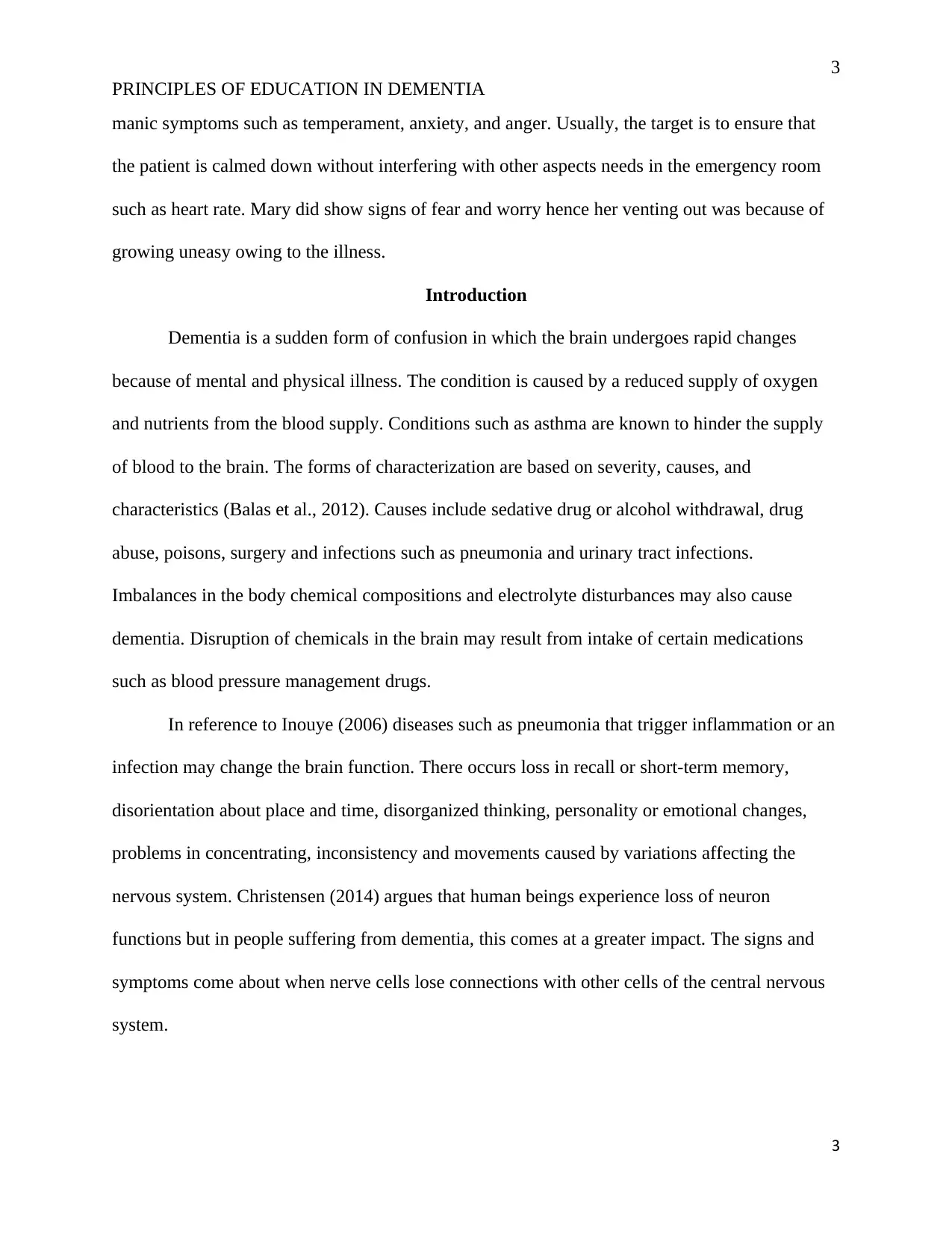
3
PRINCIPLES OF EDUCATION IN DEMENTIA
manic symptoms such as temperament, anxiety, and anger. Usually, the target is to ensure that
the patient is calmed down without interfering with other aspects needs in the emergency room
such as heart rate. Mary did show signs of fear and worry hence her venting out was because of
growing uneasy owing to the illness.
Introduction
Dementia is a sudden form of confusion in which the brain undergoes rapid changes
because of mental and physical illness. The condition is caused by a reduced supply of oxygen
and nutrients from the blood supply. Conditions such as asthma are known to hinder the supply
of blood to the brain. The forms of characterization are based on severity, causes, and
characteristics (Balas et al., 2012). Causes include sedative drug or alcohol withdrawal, drug
abuse, poisons, surgery and infections such as pneumonia and urinary tract infections.
Imbalances in the body chemical compositions and electrolyte disturbances may also cause
dementia. Disruption of chemicals in the brain may result from intake of certain medications
such as blood pressure management drugs.
In reference to Inouye (2006) diseases such as pneumonia that trigger inflammation or an
infection may change the brain function. There occurs loss in recall or short-term memory,
disorientation about place and time, disorganized thinking, personality or emotional changes,
problems in concentrating, inconsistency and movements caused by variations affecting the
nervous system. Christensen (2014) argues that human beings experience loss of neuron
functions but in people suffering from dementia, this comes at a greater impact. The signs and
symptoms come about when nerve cells lose connections with other cells of the central nervous
system.
3
PRINCIPLES OF EDUCATION IN DEMENTIA
manic symptoms such as temperament, anxiety, and anger. Usually, the target is to ensure that
the patient is calmed down without interfering with other aspects needs in the emergency room
such as heart rate. Mary did show signs of fear and worry hence her venting out was because of
growing uneasy owing to the illness.
Introduction
Dementia is a sudden form of confusion in which the brain undergoes rapid changes
because of mental and physical illness. The condition is caused by a reduced supply of oxygen
and nutrients from the blood supply. Conditions such as asthma are known to hinder the supply
of blood to the brain. The forms of characterization are based on severity, causes, and
characteristics (Balas et al., 2012). Causes include sedative drug or alcohol withdrawal, drug
abuse, poisons, surgery and infections such as pneumonia and urinary tract infections.
Imbalances in the body chemical compositions and electrolyte disturbances may also cause
dementia. Disruption of chemicals in the brain may result from intake of certain medications
such as blood pressure management drugs.
In reference to Inouye (2006) diseases such as pneumonia that trigger inflammation or an
infection may change the brain function. There occurs loss in recall or short-term memory,
disorientation about place and time, disorganized thinking, personality or emotional changes,
problems in concentrating, inconsistency and movements caused by variations affecting the
nervous system. Christensen (2014) argues that human beings experience loss of neuron
functions but in people suffering from dementia, this comes at a greater impact. The signs and
symptoms come about when nerve cells lose connections with other cells of the central nervous
system.
3
⊘ This is a preview!⊘
Do you want full access?
Subscribe today to unlock all pages.

Trusted by 1+ million students worldwide
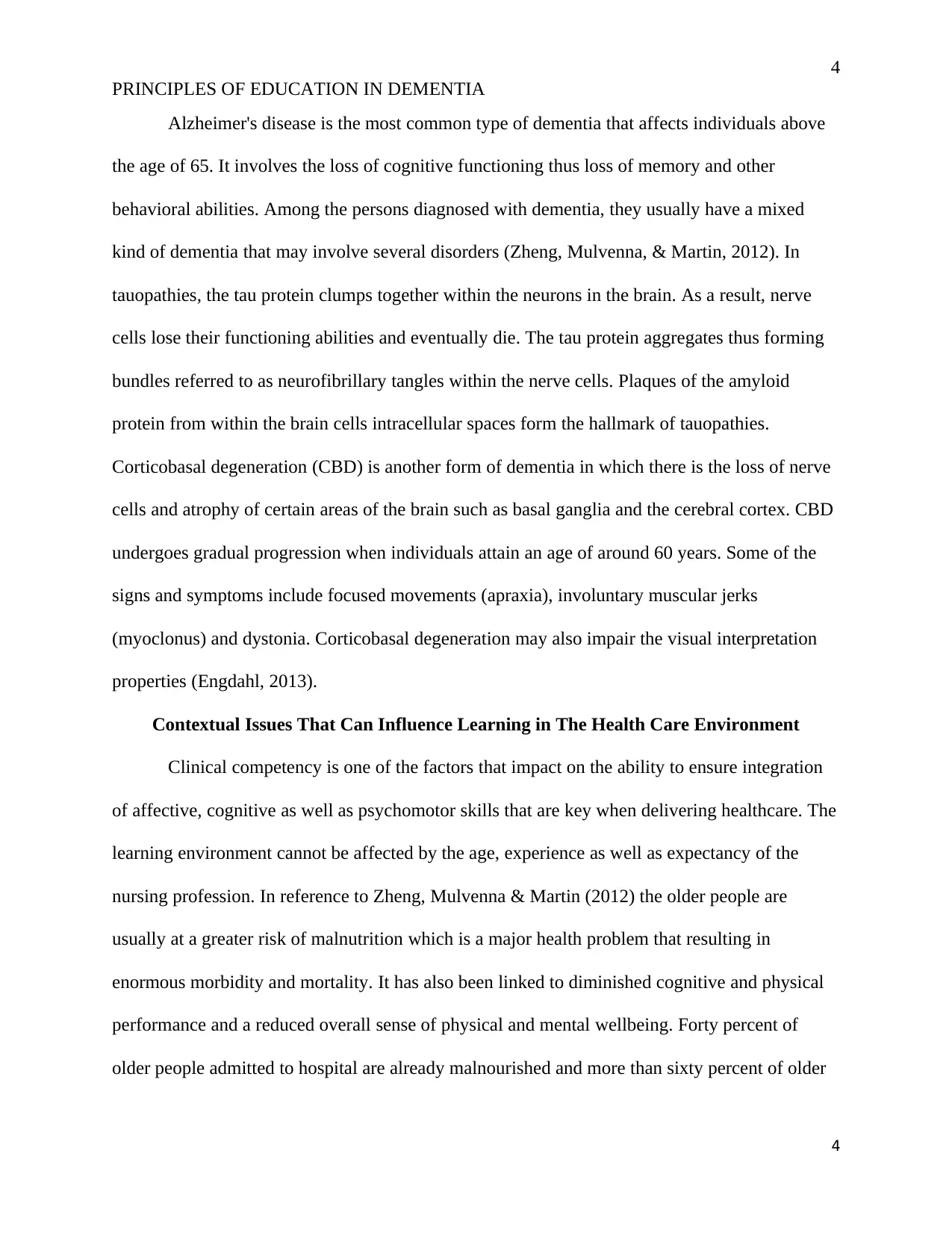
4
PRINCIPLES OF EDUCATION IN DEMENTIA
Alzheimer's disease is the most common type of dementia that affects individuals above
the age of 65. It involves the loss of cognitive functioning thus loss of memory and other
behavioral abilities. Among the persons diagnosed with dementia, they usually have a mixed
kind of dementia that may involve several disorders (Zheng, Mulvenna, & Martin, 2012). In
tauopathies, the tau protein clumps together within the neurons in the brain. As a result, nerve
cells lose their functioning abilities and eventually die. The tau protein aggregates thus forming
bundles referred to as neurofibrillary tangles within the nerve cells. Plaques of the amyloid
protein from within the brain cells intracellular spaces form the hallmark of tauopathies.
Corticobasal degeneration (CBD) is another form of dementia in which there is the loss of nerve
cells and atrophy of certain areas of the brain such as basal ganglia and the cerebral cortex. CBD
undergoes gradual progression when individuals attain an age of around 60 years. Some of the
signs and symptoms include focused movements (apraxia), involuntary muscular jerks
(myoclonus) and dystonia. Corticobasal degeneration may also impair the visual interpretation
properties (Engdahl, 2013).
Contextual Issues That Can Influence Learning in The Health Care Environment
Clinical competency is one of the factors that impact on the ability to ensure integration
of affective, cognitive as well as psychomotor skills that are key when delivering healthcare. The
learning environment cannot be affected by the age, experience as well as expectancy of the
nursing profession. In reference to Zheng, Mulvenna & Martin (2012) the older people are
usually at a greater risk of malnutrition which is a major health problem that resulting in
enormous morbidity and mortality. It has also been linked to diminished cognitive and physical
performance and a reduced overall sense of physical and mental wellbeing. Forty percent of
older people admitted to hospital are already malnourished and more than sixty percent of older
4
PRINCIPLES OF EDUCATION IN DEMENTIA
Alzheimer's disease is the most common type of dementia that affects individuals above
the age of 65. It involves the loss of cognitive functioning thus loss of memory and other
behavioral abilities. Among the persons diagnosed with dementia, they usually have a mixed
kind of dementia that may involve several disorders (Zheng, Mulvenna, & Martin, 2012). In
tauopathies, the tau protein clumps together within the neurons in the brain. As a result, nerve
cells lose their functioning abilities and eventually die. The tau protein aggregates thus forming
bundles referred to as neurofibrillary tangles within the nerve cells. Plaques of the amyloid
protein from within the brain cells intracellular spaces form the hallmark of tauopathies.
Corticobasal degeneration (CBD) is another form of dementia in which there is the loss of nerve
cells and atrophy of certain areas of the brain such as basal ganglia and the cerebral cortex. CBD
undergoes gradual progression when individuals attain an age of around 60 years. Some of the
signs and symptoms include focused movements (apraxia), involuntary muscular jerks
(myoclonus) and dystonia. Corticobasal degeneration may also impair the visual interpretation
properties (Engdahl, 2013).
Contextual Issues That Can Influence Learning in The Health Care Environment
Clinical competency is one of the factors that impact on the ability to ensure integration
of affective, cognitive as well as psychomotor skills that are key when delivering healthcare. The
learning environment cannot be affected by the age, experience as well as expectancy of the
nursing profession. In reference to Zheng, Mulvenna & Martin (2012) the older people are
usually at a greater risk of malnutrition which is a major health problem that resulting in
enormous morbidity and mortality. It has also been linked to diminished cognitive and physical
performance and a reduced overall sense of physical and mental wellbeing. Forty percent of
older people admitted to hospital are already malnourished and more than sixty percent of older
4
Paraphrase This Document
Need a fresh take? Get an instant paraphrase of this document with our AI Paraphraser
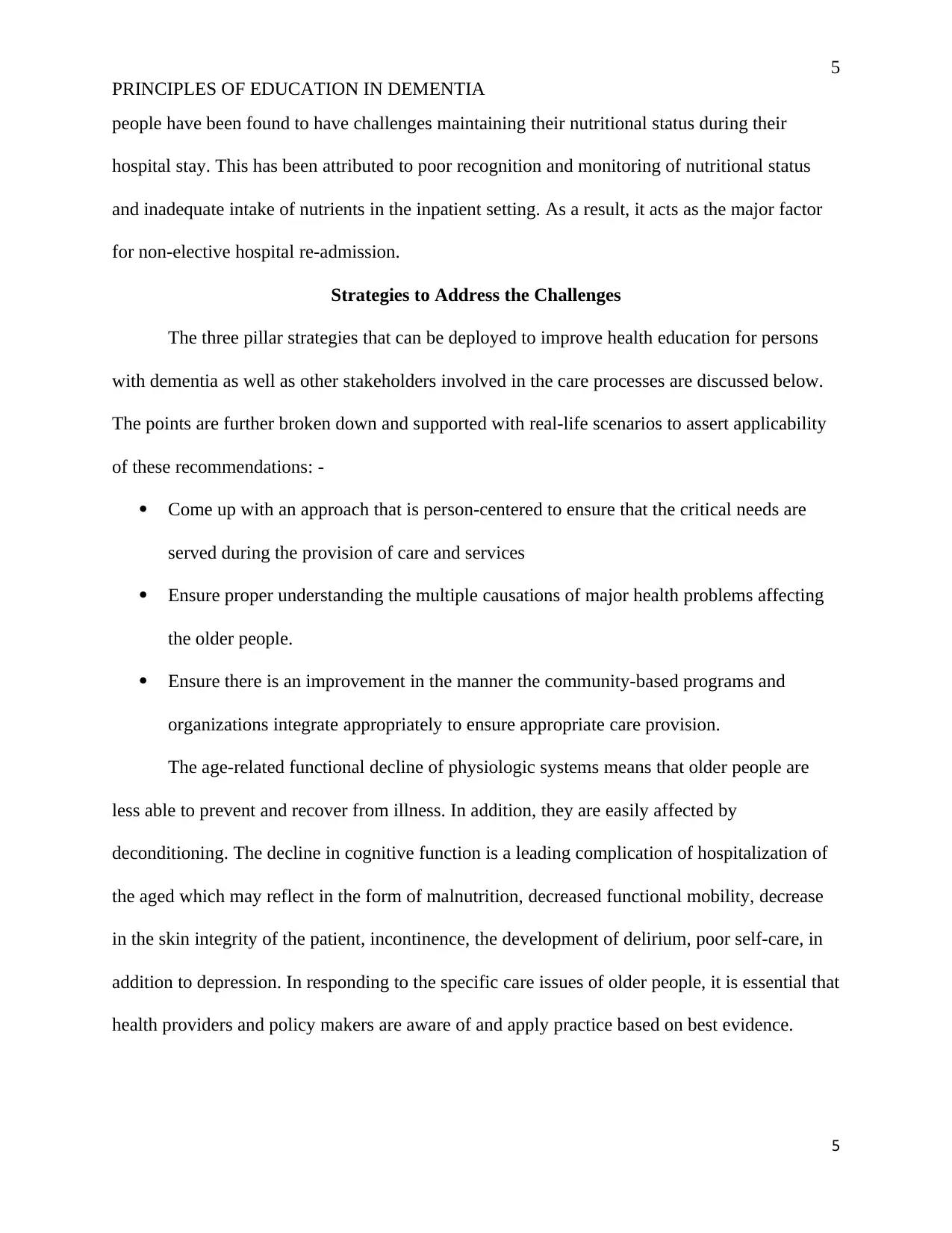
5
PRINCIPLES OF EDUCATION IN DEMENTIA
people have been found to have challenges maintaining their nutritional status during their
hospital stay. This has been attributed to poor recognition and monitoring of nutritional status
and inadequate intake of nutrients in the inpatient setting. As a result, it acts as the major factor
for non-elective hospital re-admission.
Strategies to Address the Challenges
The three pillar strategies that can be deployed to improve health education for persons
with dementia as well as other stakeholders involved in the care processes are discussed below.
The points are further broken down and supported with real-life scenarios to assert applicability
of these recommendations: -
Come up with an approach that is person-centered to ensure that the critical needs are
served during the provision of care and services
Ensure proper understanding the multiple causations of major health problems affecting
the older people.
Ensure there is an improvement in the manner the community-based programs and
organizations integrate appropriately to ensure appropriate care provision.
The age-related functional decline of physiologic systems means that older people are
less able to prevent and recover from illness. In addition, they are easily affected by
deconditioning. The decline in cognitive function is a leading complication of hospitalization of
the aged which may reflect in the form of malnutrition, decreased functional mobility, decrease
in the skin integrity of the patient, incontinence, the development of delirium, poor self-care, in
addition to depression. In responding to the specific care issues of older people, it is essential that
health providers and policy makers are aware of and apply practice based on best evidence.
5
PRINCIPLES OF EDUCATION IN DEMENTIA
people have been found to have challenges maintaining their nutritional status during their
hospital stay. This has been attributed to poor recognition and monitoring of nutritional status
and inadequate intake of nutrients in the inpatient setting. As a result, it acts as the major factor
for non-elective hospital re-admission.
Strategies to Address the Challenges
The three pillar strategies that can be deployed to improve health education for persons
with dementia as well as other stakeholders involved in the care processes are discussed below.
The points are further broken down and supported with real-life scenarios to assert applicability
of these recommendations: -
Come up with an approach that is person-centered to ensure that the critical needs are
served during the provision of care and services
Ensure proper understanding the multiple causations of major health problems affecting
the older people.
Ensure there is an improvement in the manner the community-based programs and
organizations integrate appropriately to ensure appropriate care provision.
The age-related functional decline of physiologic systems means that older people are
less able to prevent and recover from illness. In addition, they are easily affected by
deconditioning. The decline in cognitive function is a leading complication of hospitalization of
the aged which may reflect in the form of malnutrition, decreased functional mobility, decrease
in the skin integrity of the patient, incontinence, the development of delirium, poor self-care, in
addition to depression. In responding to the specific care issues of older people, it is essential that
health providers and policy makers are aware of and apply practice based on best evidence.
5
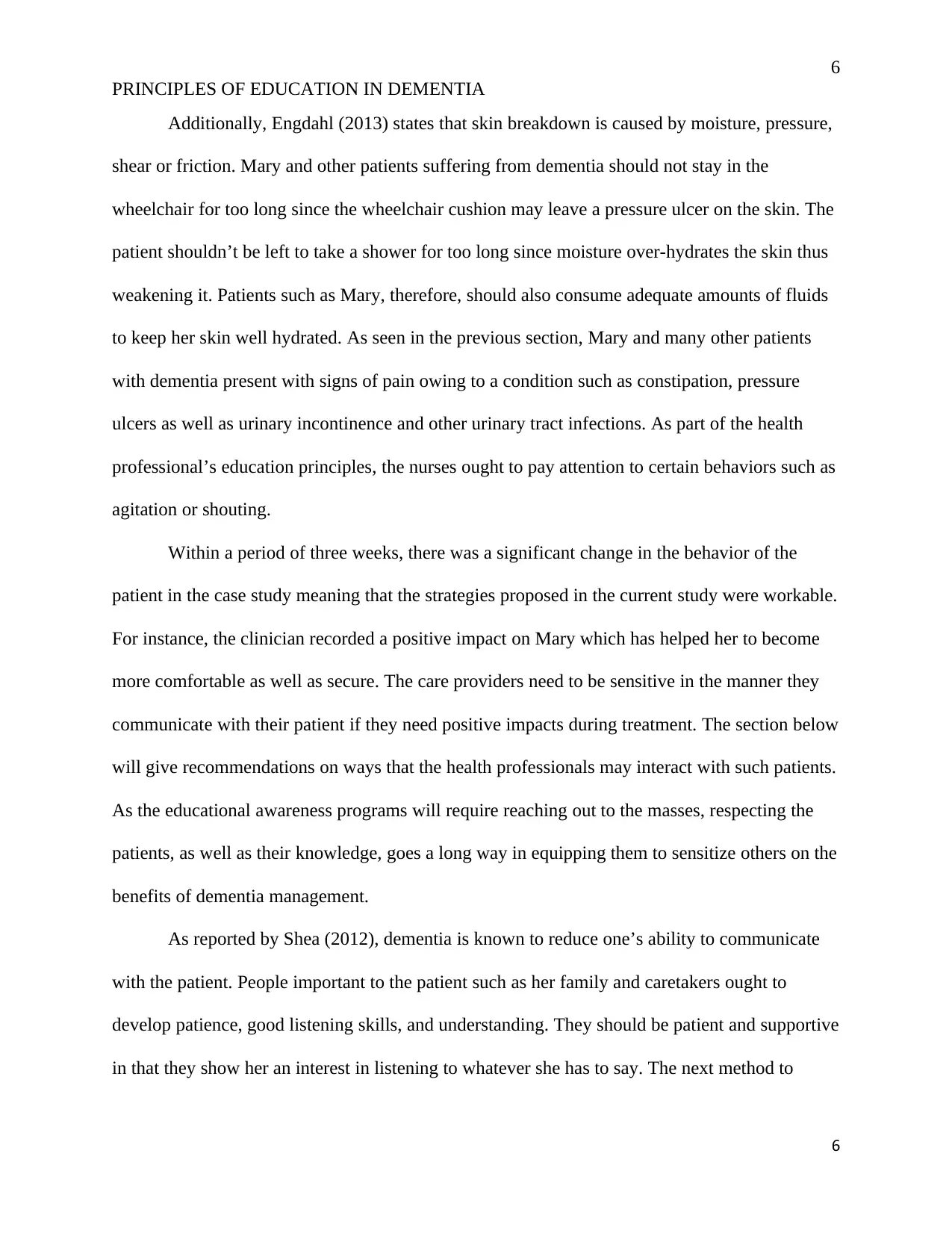
6
PRINCIPLES OF EDUCATION IN DEMENTIA
Additionally, Engdahl (2013) states that skin breakdown is caused by moisture, pressure,
shear or friction. Mary and other patients suffering from dementia should not stay in the
wheelchair for too long since the wheelchair cushion may leave a pressure ulcer on the skin. The
patient shouldn’t be left to take a shower for too long since moisture over-hydrates the skin thus
weakening it. Patients such as Mary, therefore, should also consume adequate amounts of fluids
to keep her skin well hydrated. As seen in the previous section, Mary and many other patients
with dementia present with signs of pain owing to a condition such as constipation, pressure
ulcers as well as urinary incontinence and other urinary tract infections. As part of the health
professional’s education principles, the nurses ought to pay attention to certain behaviors such as
agitation or shouting.
Within a period of three weeks, there was a significant change in the behavior of the
patient in the case study meaning that the strategies proposed in the current study were workable.
For instance, the clinician recorded a positive impact on Mary which has helped her to become
more comfortable as well as secure. The care providers need to be sensitive in the manner they
communicate with their patient if they need positive impacts during treatment. The section below
will give recommendations on ways that the health professionals may interact with such patients.
As the educational awareness programs will require reaching out to the masses, respecting the
patients, as well as their knowledge, goes a long way in equipping them to sensitize others on the
benefits of dementia management.
As reported by Shea (2012), dementia is known to reduce one’s ability to communicate
with the patient. People important to the patient such as her family and caretakers ought to
develop patience, good listening skills, and understanding. They should be patient and supportive
in that they show her an interest in listening to whatever she has to say. The next method to
6
PRINCIPLES OF EDUCATION IN DEMENTIA
Additionally, Engdahl (2013) states that skin breakdown is caused by moisture, pressure,
shear or friction. Mary and other patients suffering from dementia should not stay in the
wheelchair for too long since the wheelchair cushion may leave a pressure ulcer on the skin. The
patient shouldn’t be left to take a shower for too long since moisture over-hydrates the skin thus
weakening it. Patients such as Mary, therefore, should also consume adequate amounts of fluids
to keep her skin well hydrated. As seen in the previous section, Mary and many other patients
with dementia present with signs of pain owing to a condition such as constipation, pressure
ulcers as well as urinary incontinence and other urinary tract infections. As part of the health
professional’s education principles, the nurses ought to pay attention to certain behaviors such as
agitation or shouting.
Within a period of three weeks, there was a significant change in the behavior of the
patient in the case study meaning that the strategies proposed in the current study were workable.
For instance, the clinician recorded a positive impact on Mary which has helped her to become
more comfortable as well as secure. The care providers need to be sensitive in the manner they
communicate with their patient if they need positive impacts during treatment. The section below
will give recommendations on ways that the health professionals may interact with such patients.
As the educational awareness programs will require reaching out to the masses, respecting the
patients, as well as their knowledge, goes a long way in equipping them to sensitize others on the
benefits of dementia management.
As reported by Shea (2012), dementia is known to reduce one’s ability to communicate
with the patient. People important to the patient such as her family and caretakers ought to
develop patience, good listening skills, and understanding. They should be patient and supportive
in that they show her an interest in listening to whatever she has to say. The next method to
6
⊘ This is a preview!⊘
Do you want full access?
Subscribe today to unlock all pages.

Trusted by 1+ million students worldwide
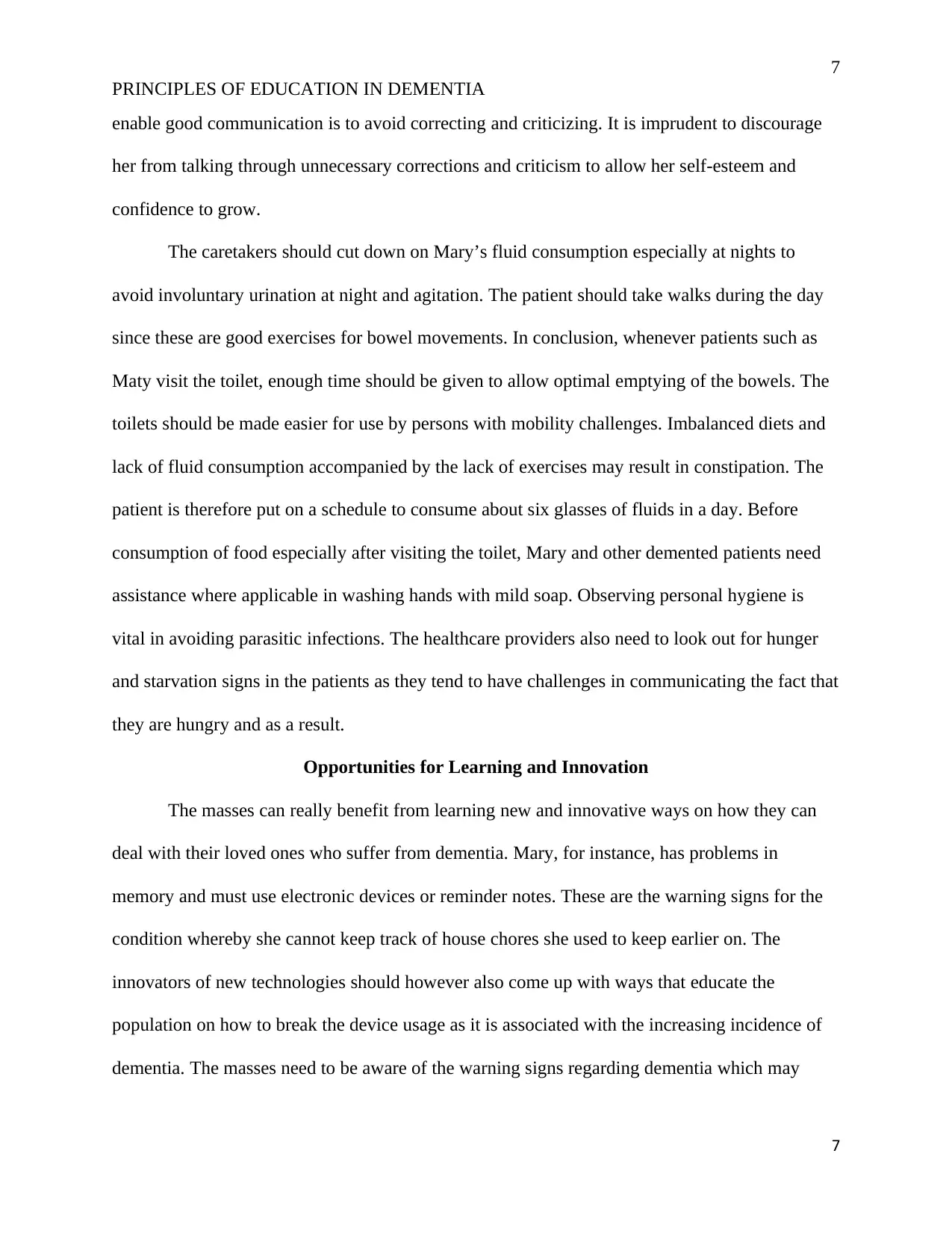
7
PRINCIPLES OF EDUCATION IN DEMENTIA
enable good communication is to avoid correcting and criticizing. It is imprudent to discourage
her from talking through unnecessary corrections and criticism to allow her self-esteem and
confidence to grow.
The caretakers should cut down on Mary’s fluid consumption especially at nights to
avoid involuntary urination at night and agitation. The patient should take walks during the day
since these are good exercises for bowel movements. In conclusion, whenever patients such as
Maty visit the toilet, enough time should be given to allow optimal emptying of the bowels. The
toilets should be made easier for use by persons with mobility challenges. Imbalanced diets and
lack of fluid consumption accompanied by the lack of exercises may result in constipation. The
patient is therefore put on a schedule to consume about six glasses of fluids in a day. Before
consumption of food especially after visiting the toilet, Mary and other demented patients need
assistance where applicable in washing hands with mild soap. Observing personal hygiene is
vital in avoiding parasitic infections. The healthcare providers also need to look out for hunger
and starvation signs in the patients as they tend to have challenges in communicating the fact that
they are hungry and as a result.
Opportunities for Learning and Innovation
The masses can really benefit from learning new and innovative ways on how they can
deal with their loved ones who suffer from dementia. Mary, for instance, has problems in
memory and must use electronic devices or reminder notes. These are the warning signs for the
condition whereby she cannot keep track of house chores she used to keep earlier on. The
innovators of new technologies should however also come up with ways that educate the
population on how to break the device usage as it is associated with the increasing incidence of
dementia. The masses need to be aware of the warning signs regarding dementia which may
7
PRINCIPLES OF EDUCATION IN DEMENTIA
enable good communication is to avoid correcting and criticizing. It is imprudent to discourage
her from talking through unnecessary corrections and criticism to allow her self-esteem and
confidence to grow.
The caretakers should cut down on Mary’s fluid consumption especially at nights to
avoid involuntary urination at night and agitation. The patient should take walks during the day
since these are good exercises for bowel movements. In conclusion, whenever patients such as
Maty visit the toilet, enough time should be given to allow optimal emptying of the bowels. The
toilets should be made easier for use by persons with mobility challenges. Imbalanced diets and
lack of fluid consumption accompanied by the lack of exercises may result in constipation. The
patient is therefore put on a schedule to consume about six glasses of fluids in a day. Before
consumption of food especially after visiting the toilet, Mary and other demented patients need
assistance where applicable in washing hands with mild soap. Observing personal hygiene is
vital in avoiding parasitic infections. The healthcare providers also need to look out for hunger
and starvation signs in the patients as they tend to have challenges in communicating the fact that
they are hungry and as a result.
Opportunities for Learning and Innovation
The masses can really benefit from learning new and innovative ways on how they can
deal with their loved ones who suffer from dementia. Mary, for instance, has problems in
memory and must use electronic devices or reminder notes. These are the warning signs for the
condition whereby she cannot keep track of house chores she used to keep earlier on. The
innovators of new technologies should however also come up with ways that educate the
population on how to break the device usage as it is associated with the increasing incidence of
dementia. The masses need to be aware of the warning signs regarding dementia which may
7
Paraphrase This Document
Need a fresh take? Get an instant paraphrase of this document with our AI Paraphraser
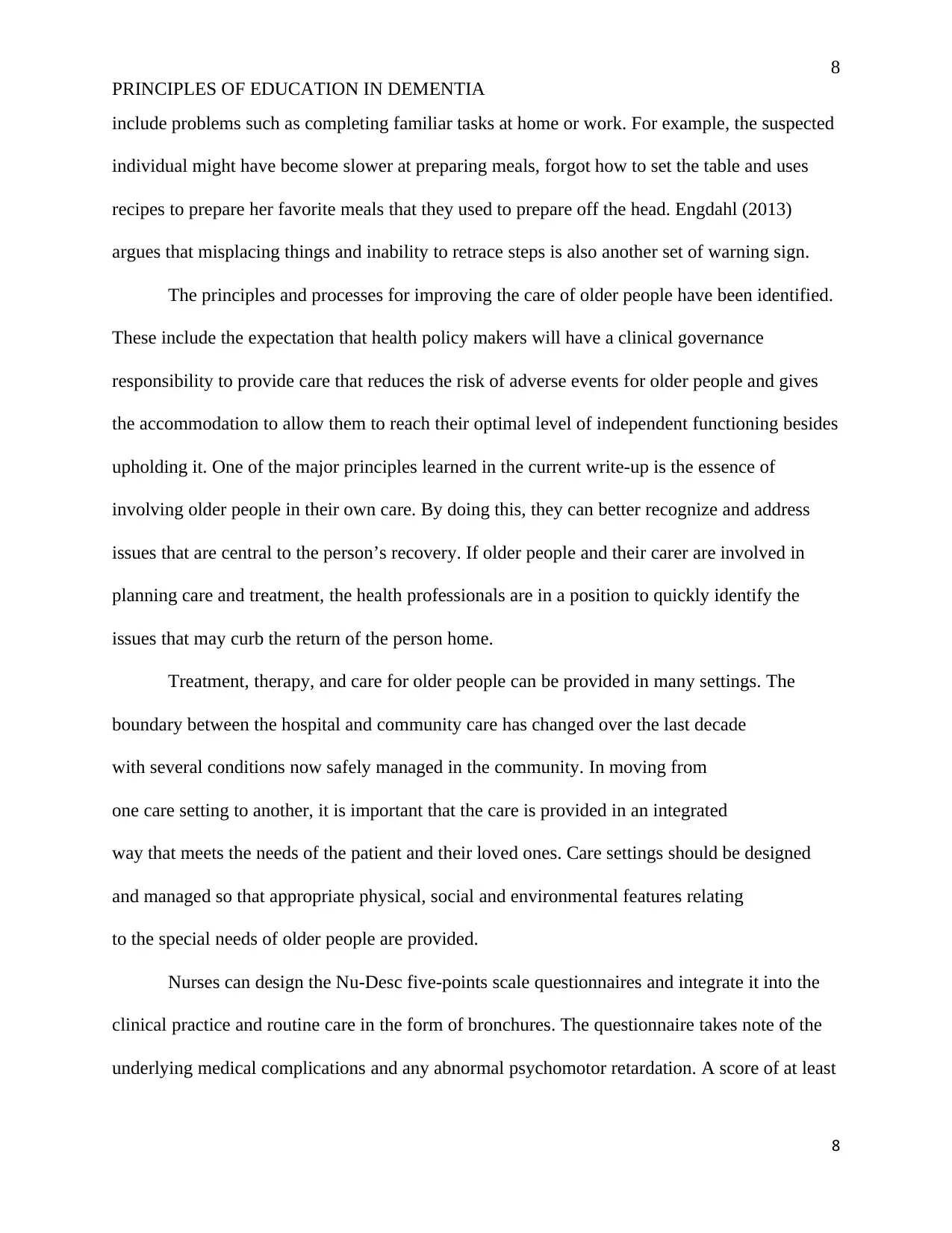
8
PRINCIPLES OF EDUCATION IN DEMENTIA
include problems such as completing familiar tasks at home or work. For example, the suspected
individual might have become slower at preparing meals, forgot how to set the table and uses
recipes to prepare her favorite meals that they used to prepare off the head. Engdahl (2013)
argues that misplacing things and inability to retrace steps is also another set of warning sign.
The principles and processes for improving the care of older people have been identified.
These include the expectation that health policy makers will have a clinical governance
responsibility to provide care that reduces the risk of adverse events for older people and gives
the accommodation to allow them to reach their optimal level of independent functioning besides
upholding it. One of the major principles learned in the current write-up is the essence of
involving older people in their own care. By doing this, they can better recognize and address
issues that are central to the person’s recovery. If older people and their carer are involved in
planning care and treatment, the health professionals are in a position to quickly identify the
issues that may curb the return of the person home.
Treatment, therapy, and care for older people can be provided in many settings. The
boundary between the hospital and community care has changed over the last decade
with several conditions now safely managed in the community. In moving from
one care setting to another, it is important that the care is provided in an integrated
way that meets the needs of the patient and their loved ones. Care settings should be designed
and managed so that appropriate physical, social and environmental features relating
to the special needs of older people are provided.
Nurses can design the Nu-Desc five-points scale questionnaires and integrate it into the
clinical practice and routine care in the form of bronchures. The questionnaire takes note of the
underlying medical complications and any abnormal psychomotor retardation. A score of at least
8
PRINCIPLES OF EDUCATION IN DEMENTIA
include problems such as completing familiar tasks at home or work. For example, the suspected
individual might have become slower at preparing meals, forgot how to set the table and uses
recipes to prepare her favorite meals that they used to prepare off the head. Engdahl (2013)
argues that misplacing things and inability to retrace steps is also another set of warning sign.
The principles and processes for improving the care of older people have been identified.
These include the expectation that health policy makers will have a clinical governance
responsibility to provide care that reduces the risk of adverse events for older people and gives
the accommodation to allow them to reach their optimal level of independent functioning besides
upholding it. One of the major principles learned in the current write-up is the essence of
involving older people in their own care. By doing this, they can better recognize and address
issues that are central to the person’s recovery. If older people and their carer are involved in
planning care and treatment, the health professionals are in a position to quickly identify the
issues that may curb the return of the person home.
Treatment, therapy, and care for older people can be provided in many settings. The
boundary between the hospital and community care has changed over the last decade
with several conditions now safely managed in the community. In moving from
one care setting to another, it is important that the care is provided in an integrated
way that meets the needs of the patient and their loved ones. Care settings should be designed
and managed so that appropriate physical, social and environmental features relating
to the special needs of older people are provided.
Nurses can design the Nu-Desc five-points scale questionnaires and integrate it into the
clinical practice and routine care in the form of bronchures. The questionnaire takes note of the
underlying medical complications and any abnormal psychomotor retardation. A score of at least
8
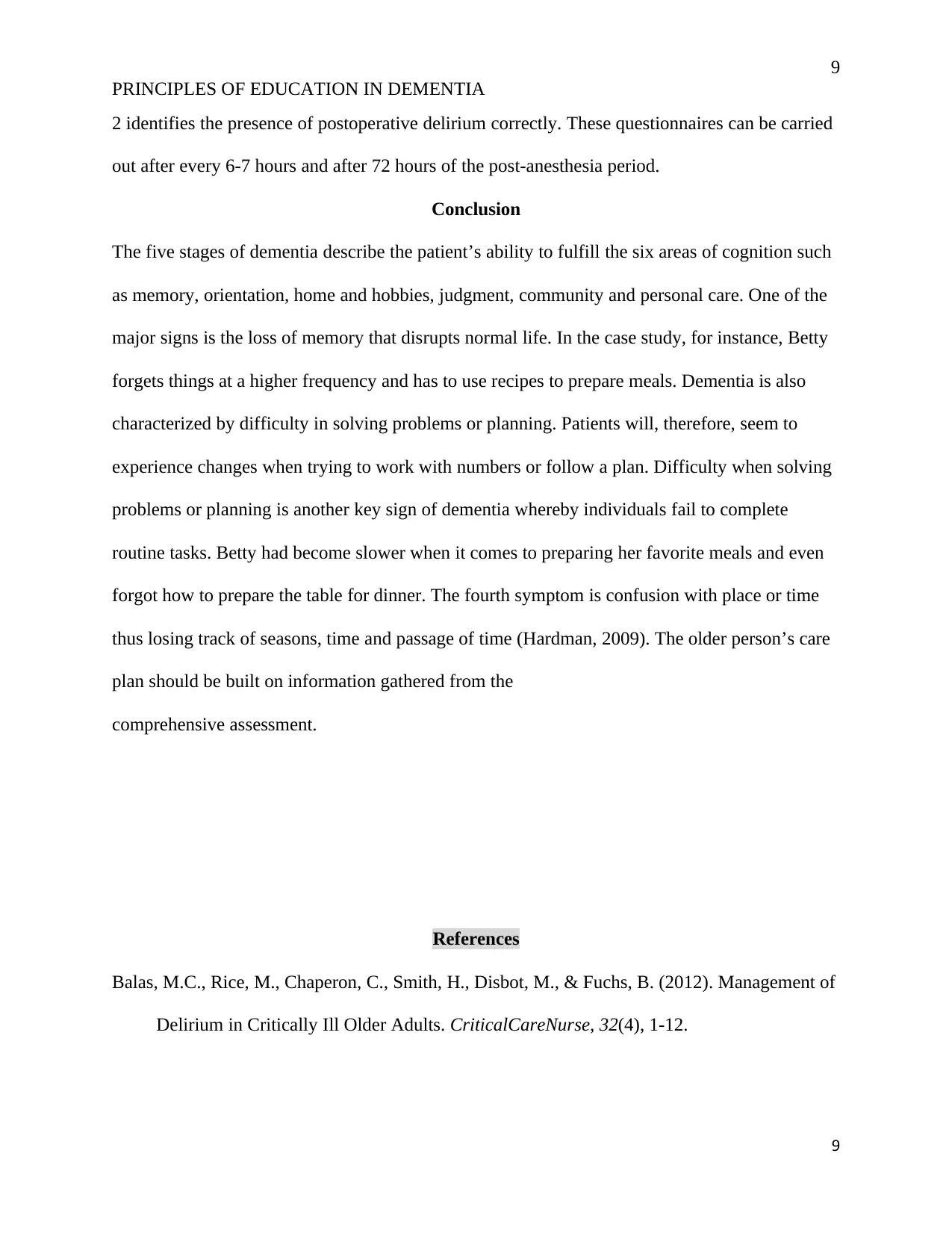
9
PRINCIPLES OF EDUCATION IN DEMENTIA
2 identifies the presence of postoperative delirium correctly. These questionnaires can be carried
out after every 6-7 hours and after 72 hours of the post-anesthesia period.
Conclusion
The five stages of dementia describe the patient’s ability to fulfill the six areas of cognition such
as memory, orientation, home and hobbies, judgment, community and personal care. One of the
major signs is the loss of memory that disrupts normal life. In the case study, for instance, Betty
forgets things at a higher frequency and has to use recipes to prepare meals. Dementia is also
characterized by difficulty in solving problems or planning. Patients will, therefore, seem to
experience changes when trying to work with numbers or follow a plan. Difficulty when solving
problems or planning is another key sign of dementia whereby individuals fail to complete
routine tasks. Betty had become slower when it comes to preparing her favorite meals and even
forgot how to prepare the table for dinner. The fourth symptom is confusion with place or time
thus losing track of seasons, time and passage of time (Hardman, 2009). The older person’s care
plan should be built on information gathered from the
comprehensive assessment.
References
Balas, M.C., Rice, M., Chaperon, C., Smith, H., Disbot, M., & Fuchs, B. (2012). Management of
Delirium in Critically Ill Older Adults. CriticalCareNurse, 32(4), 1-12.
9
PRINCIPLES OF EDUCATION IN DEMENTIA
2 identifies the presence of postoperative delirium correctly. These questionnaires can be carried
out after every 6-7 hours and after 72 hours of the post-anesthesia period.
Conclusion
The five stages of dementia describe the patient’s ability to fulfill the six areas of cognition such
as memory, orientation, home and hobbies, judgment, community and personal care. One of the
major signs is the loss of memory that disrupts normal life. In the case study, for instance, Betty
forgets things at a higher frequency and has to use recipes to prepare meals. Dementia is also
characterized by difficulty in solving problems or planning. Patients will, therefore, seem to
experience changes when trying to work with numbers or follow a plan. Difficulty when solving
problems or planning is another key sign of dementia whereby individuals fail to complete
routine tasks. Betty had become slower when it comes to preparing her favorite meals and even
forgot how to prepare the table for dinner. The fourth symptom is confusion with place or time
thus losing track of seasons, time and passage of time (Hardman, 2009). The older person’s care
plan should be built on information gathered from the
comprehensive assessment.
References
Balas, M.C., Rice, M., Chaperon, C., Smith, H., Disbot, M., & Fuchs, B. (2012). Management of
Delirium in Critically Ill Older Adults. CriticalCareNurse, 32(4), 1-12.
9
⊘ This is a preview!⊘
Do you want full access?
Subscribe today to unlock all pages.

Trusted by 1+ million students worldwide
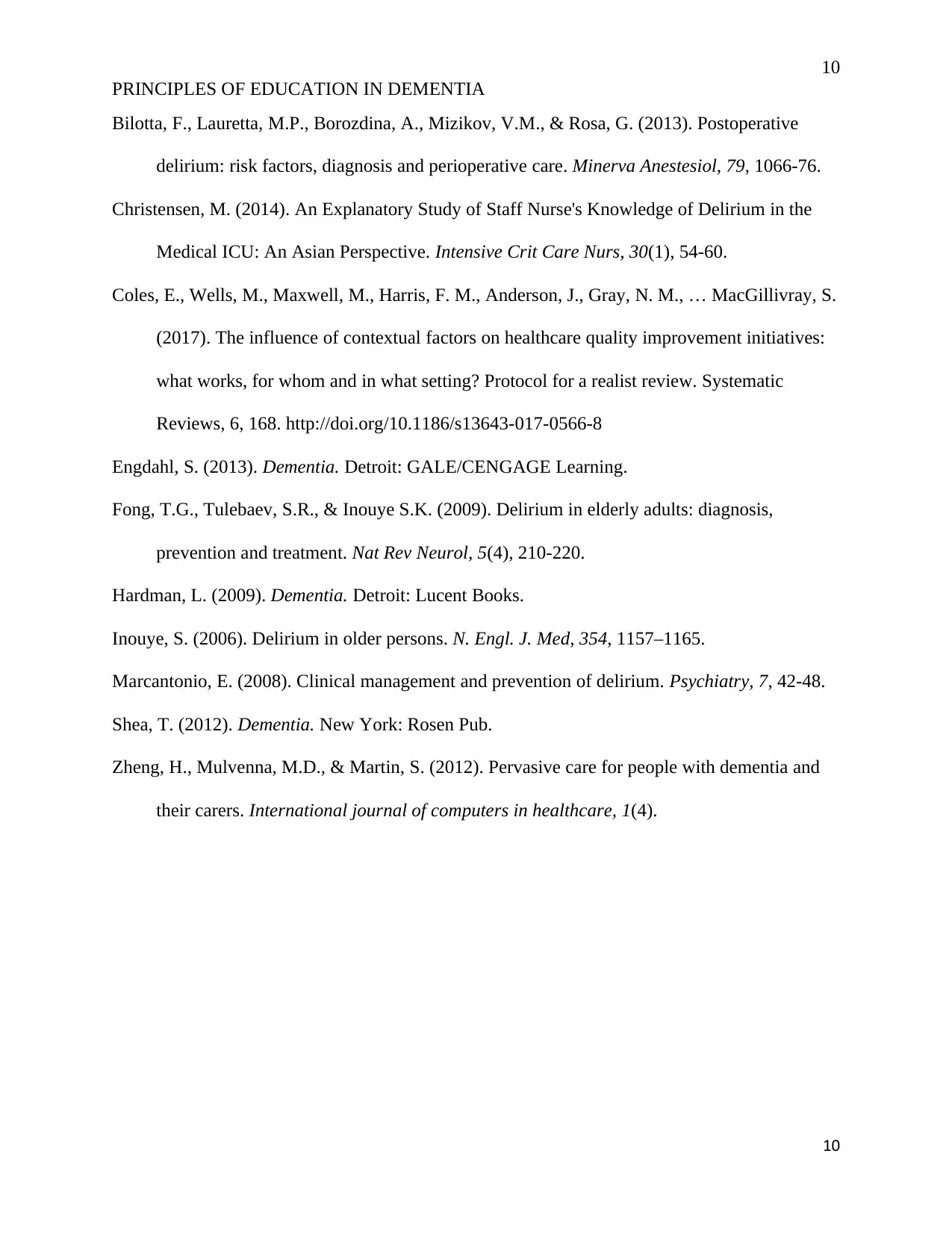
10
PRINCIPLES OF EDUCATION IN DEMENTIA
Bilotta, F., Lauretta, M.P., Borozdina, A., Mizikov, V.M., & Rosa, G. (2013). Postoperative
delirium: risk factors, diagnosis and perioperative care. Minerva Anestesiol, 79, 1066-76.
Christensen, M. (2014). An Explanatory Study of Staff Nurse's Knowledge of Delirium in the
Medical ICU: An Asian Perspective. Intensive Crit Care Nurs, 30(1), 54-60.
Coles, E., Wells, M., Maxwell, M., Harris, F. M., Anderson, J., Gray, N. M., … MacGillivray, S.
(2017). The influence of contextual factors on healthcare quality improvement initiatives:
what works, for whom and in what setting? Protocol for a realist review. Systematic
Reviews, 6, 168. http://doi.org/10.1186/s13643-017-0566-8
Engdahl, S. (2013). Dementia. Detroit: GALE/CENGAGE Learning.
Fong, T.G., Tulebaev, S.R., & Inouye S.K. (2009). Delirium in elderly adults: diagnosis,
prevention and treatment. Nat Rev Neurol, 5(4), 210-220.
Hardman, L. (2009). Dementia. Detroit: Lucent Books.
Inouye, S. (2006). Delirium in older persons. N. Engl. J. Med, 354, 1157–1165.
Marcantonio, E. (2008). Clinical management and prevention of delirium. Psychiatry, 7, 42-48.
Shea, T. (2012). Dementia. New York: Rosen Pub.
Zheng, H., Mulvenna, M.D., & Martin, S. (2012). Pervasive care for people with dementia and
their carers. International journal of computers in healthcare, 1(4).
10
PRINCIPLES OF EDUCATION IN DEMENTIA
Bilotta, F., Lauretta, M.P., Borozdina, A., Mizikov, V.M., & Rosa, G. (2013). Postoperative
delirium: risk factors, diagnosis and perioperative care. Minerva Anestesiol, 79, 1066-76.
Christensen, M. (2014). An Explanatory Study of Staff Nurse's Knowledge of Delirium in the
Medical ICU: An Asian Perspective. Intensive Crit Care Nurs, 30(1), 54-60.
Coles, E., Wells, M., Maxwell, M., Harris, F. M., Anderson, J., Gray, N. M., … MacGillivray, S.
(2017). The influence of contextual factors on healthcare quality improvement initiatives:
what works, for whom and in what setting? Protocol for a realist review. Systematic
Reviews, 6, 168. http://doi.org/10.1186/s13643-017-0566-8
Engdahl, S. (2013). Dementia. Detroit: GALE/CENGAGE Learning.
Fong, T.G., Tulebaev, S.R., & Inouye S.K. (2009). Delirium in elderly adults: diagnosis,
prevention and treatment. Nat Rev Neurol, 5(4), 210-220.
Hardman, L. (2009). Dementia. Detroit: Lucent Books.
Inouye, S. (2006). Delirium in older persons. N. Engl. J. Med, 354, 1157–1165.
Marcantonio, E. (2008). Clinical management and prevention of delirium. Psychiatry, 7, 42-48.
Shea, T. (2012). Dementia. New York: Rosen Pub.
Zheng, H., Mulvenna, M.D., & Martin, S. (2012). Pervasive care for people with dementia and
their carers. International journal of computers in healthcare, 1(4).
10
1 out of 10
Your All-in-One AI-Powered Toolkit for Academic Success.
+13062052269
info@desklib.com
Available 24*7 on WhatsApp / Email
![[object Object]](/_next/static/media/star-bottom.7253800d.svg)
Unlock your academic potential
Copyright © 2020–2025 A2Z Services. All Rights Reserved. Developed and managed by ZUCOL.

